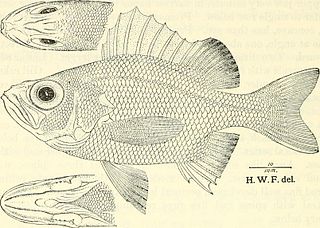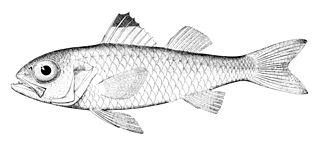
The Percidae are a family of ray-finned fish, part of the order Perciformes, which are found in fresh and brackish waters of the Northern Hemisphere. The majority are Nearctic, but there are also Palearctic species. The family contains more than 200 species in 11 genera. The perches, and their relatives are in this family; well-known species include the walleye, sauger, ruffe, and three species of perch. However, small fish known as darters are also a part of this family.

Acropomatidae is a family of fish in the order Perciformes, commonly known as lanternbellies. Acropoma species are notable for having light-emitting organs along their undersides. They are found in all temperate and tropical oceans, usually at depths of several hundred meters. There are about 32 species in as many as 9 genera, although some authorities recognise fewer genera than Fishbase does.

The southern sunfish, also known as the Ramsay's sunfish, southern ocean sunfish, short sunfish or bump-head sunfish in many parts of the world, is a fish belonging to the family Molidae. It is closely related to its congener, much wider known Mola mola, and is found in the Southern Hemisphere. It can be found basking on its side occasionally near the surface, which is thought to be used to re-heat themselves after diving in cold water for prey, recharge their oxygen stores, and attract gulls to free them of parasites.

Acropoma is a genus of fish in the family Acropomatidae, the temperate ocean-basses or lanternbellies. They are native to the Indian Ocean and western Pacific Ocean. They are characterized by a ventral luminous organ that has a luminous gland, a lens, and a reflector. The shape of the luminous organ helps distinguish the species in the genus.
The three-spined cardinalfish is a species of fish in the family Acropomatidae, the temperate ocean-basses or lanternbellies. It is endemic to the marine waters off of Australia.

The blackthroat seaperch, also known as the rosy seabass, is a species of fish in the family Acropomatidae, the temperate ocean-basses or lanternbellies. It is the only species in the monotypic genus Doederleinia. It is native to the eastern Indian Ocean and the western Pacific Ocean from Japan to Australia. In Japan it is known as Nodoguro, or Akamutsu.
Malakichthys is a genus of fish in the family Acropomatidae, the temperate ocean-basses or lanternfishes. They are native to the Indian Ocean and the western Pacific Ocean.

Neoscombrops is a genus of marine ray-finned fishes from the family Acropomatidae, the lanternbellies or glowbellies. The fish in this genus are found in the Atlantic Pacific and Indian Oceans.

Verilus sordidus is a species of fish in the family Acropomatidae, the temperate ocean-basses or lanternbellies. It is native to the central western Atlantic Ocean. It is found in the waters off Cuba to Colombia and Venezuela where it is found at depths shallower than 100 metres (330 ft) over rocky bottoms.

Acropoma japonicum, the glowbelly, is a fish species in the family Acropomatidae found in the Indo-West Pacific. It is a benthopelagic predatory fish with a bioluminescent organ on its ventral surface. The glowbelly is an important food fish in some areas.
Acropoma lecorneti is a species of ray-finned fish, a lanternbelly from the family Acropomatidae. It is found in the western Pacific Ocean where it has been recorded off Japan and New Caledonia. This species was first formally described by the French ichthyologist Pierre Fourmanoir (1924-2007) with the type locality given as north of the St Vincent Pass off the western coast of New Caledonia at a depth of 360 metres (1,180 ft). The specific name honours the skipper of the fishing boat Thalassa, Monsieur Lecornet, who took the type aboard that vessel.
Acropoma profundum, Solomon's lanternbelly, is a species of ray-finned fish, a lanternbelly from the family Acropomatidae. It is found in the western South Pacific Ocean in waters near the Solomon Islands. The types were taken from depths of 1,169–1,203 metres (3,835–3,947 ft), making this the deepest living species of the genus Acropoma.
Parascombrops pellucidus is a species of perciform fish in the Family of Acropomatidae.

Synagrops bellus, the blackmouth bass, is a species of fish in the family Acropomatidae.
Synagrops japonicus is a species of fish within the family of Acropomatidae. It was described by Döderlein in 1883.
The thinlip splitfin is a species of fish in the family Acropomatidae, the lanternbellies. It lives around Africa's Atlantic coast at a depth of 50–500 m and can grow up to 16.5 cm long.

Parascombrops philippinensis, the sharptooth seabass, is a species of fish in the family Acropomatidae, the lanternbellies. It usually inhabits a depth of 180–220 metres and lives in and around the Indian Ocean and the Pacific Ocean, where it reaches a length of around 13 centimetres.
Verilus pseudomicrolepis is a species of fish in the family Acropomatidae, the lanternbellies. It lives at a depth of approximately 200–600 metres and mainly inhabits the Caribbean Sea, reaching a length of around 14.5 centimetres.
The three-spine bass is a species of ray-finned fish, a lanternbelly from the family Acropomatidae. It is a deep water species which is found in the western Atlantic from the northeastern Gulf of Mexico to Surinam. This fish was first formally described in 1984 as Synagrops trispinosus but in 2017 was placed in the monotypic genus Caraibops.

Paracombrops is a genus of marine ray-finned fishes from the family Acropomatidae, the lanternbellies or glowbellies. The fish in this genus are found in the Indo-Pacific.









